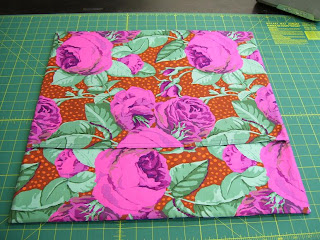i needed a quick gift. we all know the best ones are homemade. i decided to make a pillow using an tester/orphan block. i keep a box full of test blocks and orphan blocks. they are perfect for quickie gift ideas. when i make a quilt from the same block, i make a couple extra *shrug* i dunno why. i could pretend that i do it on purpose, but i don't.
i decided to make a flanged pillow. so i dug out a nice 12" finished block. i had a 16" pillow form, so i added a 2" border that coordinated with the background of the block, then another 2" border for the 'flange' of the pillow. that made everything fit. then i quilted it. (you don't have to if you don't wanna, or you could just make it from a nice decorator fabric- be creative!) so how did i do all that?
this pillow has a overhang in the back that allows the form to be taken out. that way you can wash the pillow cover.
all measurements are finished measurements- no seam allowances. my seam allowance in this entire project was 1/4 inch (click on the picture will take you to the bigger version. click 'back' on your bowser to come back here)
1. here's my block, with all it borders, quilted. like i said, you'll have to start with your pillow form. i choose a 16" form. i had a 12" block, so i added a 2" border to my block which made it 16". then i added another 2" border to that for the flange. this will be referred to throughout as the 'top' of the pillow.
2. measure the top of the pillow. mine came to 20". so i cut two rectangles 20" wide by like 18".i tend to cut the back pieces bigger than i need so i don't have to be so exact with my math...you'll see why down the road...on the edge that measures 20" turn under 1/2" , then fold it again making a nice hem. using a coordinating thread (or in my case what ever i had a full bobbin that somewhat matched) stitch the hem down. i sew 1/8" from the fold and 1/8" from the edge. these edges get alot of 'abuse' the extra stitching reinforces them.
3. fold the pillow in half and place a pin in the center. measure up 4" and down 4" and place a pin there as well. we'll be using these pins to cut our backing pieces to size. why 4 inches? i like a 8 inch over hang...you can make it whatever you like. do this on the opposite edge as well.
4.measure from the edge up to the farthest pin. write that measurement down. in my case it was 14"
5. trim both backing pieces to the size from step 4. line up you measurement line on the folded hem edge. and trim from the bottom. so- my pieces were 20" x 14" times 2. (gotta love that big 20" ruler purchase. totally worth it now)
6. see 14 inches...
7. now we are going to layer everything. place the pillow top right side up on your table. place one of the backing pieces wrong side up on the pillow top. make sure the hemmed edge is in the body of the pillow top. see picture.
8. place the other backing piece on the pillow top covering the other side. see picture.
9.pin all the edges and sew around the pillow. i backtack at the corners because they get alot of wear and tear too. don't want your 'gift' to fall apart now do we? nope- that would be embarrassing! trim the corners as shown. they will be less bulky and easy to turn. i use a bone folder to poke them out.
10. reaching through the over hang of the two backing pieces, turn the pillow right side out. take a moment to admire your work...for those worried about raw edges showing- don't worry- you're getting ahead of me :)
11. roll the seam so that it is truly on the edge of the pillow. it doesn't have to be perfect, just close. press the entire pillow to 'set' the edge.
12. using your fingers, feel the edge of the border and place pins from the back to hold the fabric. (this will be the flange...) i hope the picture illustrates this better than i can describe it...we're going to stitch in the ditch of the border to create the flange. i have learned from experience that pinning like this prevents tucks from getting sewn in...
13. this shows all the pins. if the backing is a bit bigger, that's okay. just place a pin or so to keep it from being floppy and getting in the way. make sure you securely pin the edges of the backing pieces...we don't want them to get twisted and sew that twist down. remember- at this point there is not such thing as 'over pinning'
14. i have stitched in the ditch from the front, this is the back. i used the same thread i used to hem the backing pieces. you don't have to. this would be a good opportunity to use a mono filament thread if you wanted. also- notice that i reinforced the edge of the backing piece. i would recommend that. it keeps you from breaking your stitches when you go to put the pillow form in.
15. this shows the stitch in the ditch from the front. see the pins from the backing...yes i stitch over my pins...my machine told me it was okay....i go slow anyway...
16. remove the pins, give it another press, and insert the pillow form. it should be a tight fit. now you have a good looking finished pillow. you could further embellish it with beads, trims, or fringe....you are only limited by your imagination!
this took me (not having to make the block) about 3 hours. i keep pillow forms in the house. my favorite sizes are 14 inch, 16 inch, and 18 inch. i buy 20 inch as i need them. i get them at JoAnn's with my coupon, or when they have a sale.
so make a pillow and send me a picture...i wanna see what you do with it...
Subscribe to:
Post Comments (Atom)





































Great tutorial!
ReplyDeleteNicely done...love the colors and it would look on my bed...hint hint...
ReplyDeleteI know this was created a year and a half ago, but I wanted to tell you that you did a terrific job of instruction here. I'm a retired teacher of mathematics and I do know good directions when I see them. So, pat yourself on the back for a job extremely well done!
ReplyDeleteKay in NJ